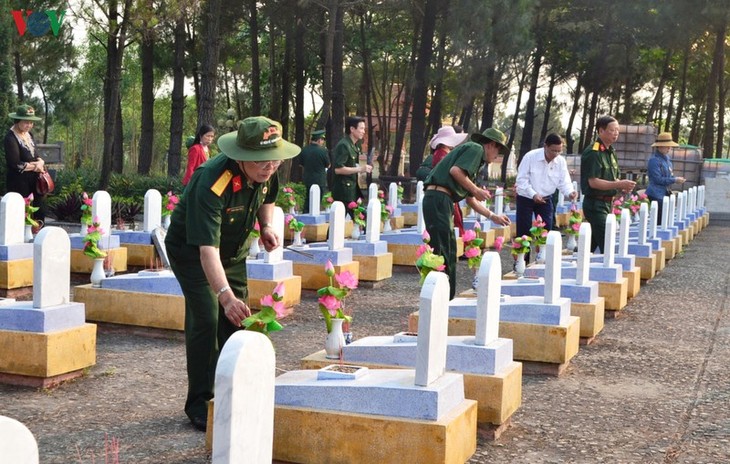(VOVWORLD) - People from across Vietnam are flooding to former battlefields in the central province of Quang Tri to pay tribute to thousands of Vietnamese soldiers who fell there during the American war. These activities mark the 73rd anniversary of Vietnam’s War Invalids and Martyrs’ Day (July 27).
 Truong Son National Martyrs Cemetery during July of 2020. Truong Son National Martyrs Cemetery during July of 2020. |
During the war, Quang Tri was called the “Land of Fire” because of heavy bombardments. This is where Vietnam’s two biggest cemeteries–the Truong Son National Martyrs Cemetery and the Road 9 National Martyrs Cemetery–are now located. Thousands of flowers and lanterns are released on the Thach Han River at nights throughout July to honor those who sacrificed their lives for national independence and liberation.
The road leading to the Truong Son National Martyrs Cemetery is now lined with rubber plantations. Le Thi Thom of Thai Nguyen province visits her father’s grave here every July. Her father, martyr Le Anh Hien, died in 1973 at Road No9 in southern Laos, when Thom was only 6 months old.
“Father! That word is sacred to me. I try to come here every year just to visit my father. I still remember the first time I visited him, I was very emotional on the train ride here. I cried a lot and called out to my dad whom I had never met. I decided not to bring his remains home, as I think he’d prefer to stay here with his comrades. They have each other here and will be remembered forever by generations of Vietnamese people,” said Thom.
Many of the graves belong to unknown soldiers. They died very young, but no one knows their names, date of birth or death, or their hometown. War veteran Nguyen Duc Nhuan of Hoa Binh province cries as he burns incense in front of his former comrades’ graves.
“We’re very emotional and speechless in our sorrow. It was a huge loss for all of us,” said Nhuan.
 War veterans burn incense at their comrades' tombs at Truong Son National Martyrs Cemetery. War veterans burn incense at their comrades' tombs at Truong Son National Martyrs Cemetery. |
War veteran Hoang Chi, Head of the Truong Son National Martyrs Cemetery, has been taking care of the site for the past 20 years. It is never easy for him to watch the countless families trying in vain to find for the remains of their loved ones, who fought on the Quang Tri battlefields. The son of a martyr himself, Chi can understand their feelings.
“A gene bank was established to facilitate DNA testing for war martyrs identification, which is a very encouraging sign. However, little has been done regarding taking samples of the martyrs’ remains for testing. This should be done as soon as possible as many of the martyrs died very young, without children, and their parents are now very old,” said Chi.
During 81 days and nights in the summer of 1972, thousands of soldiers secretly crossed the Thach Han River to protect the Quang Tri citadel. The citadel has been preserved as a war remnant and the Thach Han River is now considered a graveyard without tombs.